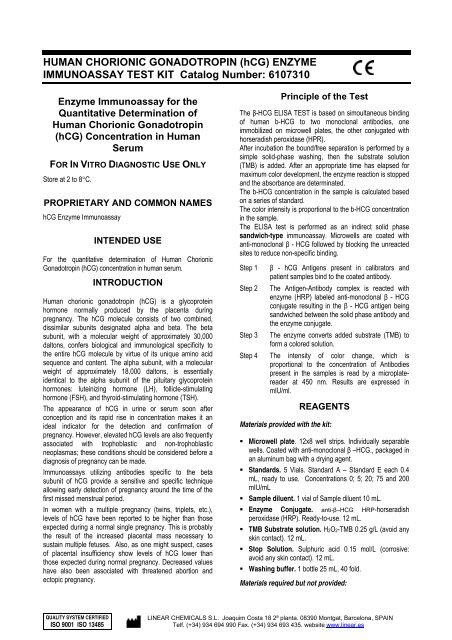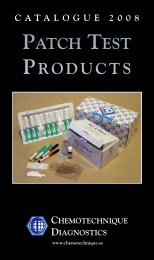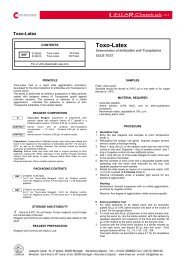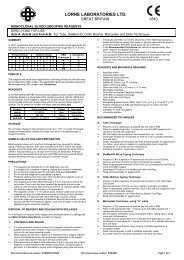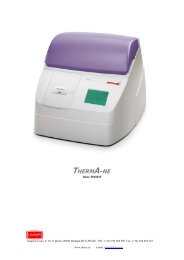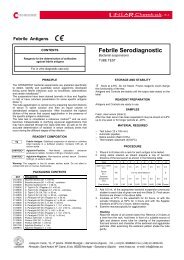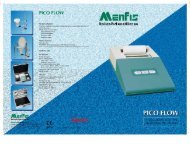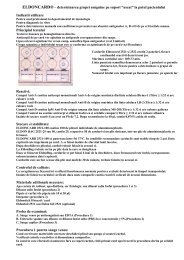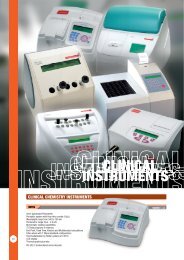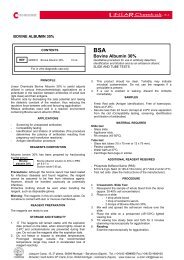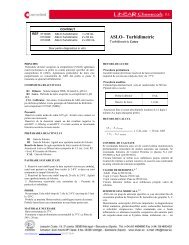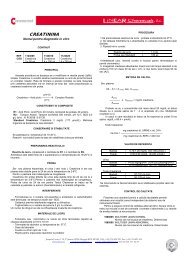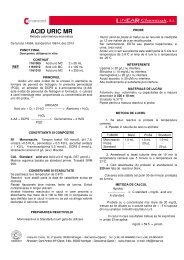HUMAN CHORIONIC GONADOTROPIN (hCG) ENZYME ... - Balmed
HUMAN CHORIONIC GONADOTROPIN (hCG) ENZYME ... - Balmed
HUMAN CHORIONIC GONADOTROPIN (hCG) ENZYME ... - Balmed
You also want an ePaper? Increase the reach of your titles
YUMPU automatically turns print PDFs into web optimized ePapers that Google loves.
<strong>HUMAN</strong> <strong>CHORIONIC</strong> <strong>GONADOTROPIN</strong> (<strong>hCG</strong>) <strong>ENZYME</strong>IMMUNOASSAY TEST KIT Catalog Number: 6107310Enzyme Immunoassay for theQuantitative Determination ofHuman Chorionic Gonadotropin(<strong>hCG</strong>) Concentration in HumanSerumFOR IN VITRO DIAGNOSTIC USE ONLYStore at 2 to 8°C.PROPRIETARY AND COMMON NAMES<strong>hCG</strong> Enzyme ImmunoassayINTENDED USEFor the quantitative determination of Human ChorionicGonadotropin (<strong>hCG</strong>) concentration in human serum.INTRODUCTIONHuman chorionic gonadotropin (<strong>hCG</strong>) is a glycoproteinhormone normally produced by the placenta duringpregnancy. The <strong>hCG</strong> molecule consists of two combined,dissimilar subunits designated alpha and beta. The betasubunit, with a molecular weight of approximately 30,000daltons, confers biological and immunological specificity tothe entire <strong>hCG</strong> molecule by virtue of its unique amino acidsequence and content. The alpha subunit, with a molecularweight of approximately 18,000 daltons, is essentiallyidentical to the alpha subunit of the pituitary glycoproteinhormones: luteinizing hormone (LH), follicle-stimulatinghormone (FSH), and thyroid-stimulating hormone (TSH).The appearance of <strong>hCG</strong> in urine or serum soon afterconception and its rapid rise in concentration makes it anideal indicator for the detection and confirmation ofpregnancy. However, elevated <strong>hCG</strong> levels are also frequentlyassociated with trophoblastic and non-trophoblasticneoplasmas; these conditions should be considered before adiagnosis of pregnancy can be made.Immunoassays utilizing antibodies specific to the betasubunit of <strong>hCG</strong> provide a sensitive and specific techniqueallowing early detection of pregnancy around the time of thefirst missed menstrual period.In women with a multiple pregnancy (twins, triplets, etc.),levels of <strong>hCG</strong> have been reported to be higher than thoseexpected during a normal single pregnancy. This is probablythe result of the increased placental mass necessary tosustain multiple fetuses. Also, as one might suspect, casesof placental insufficiency show levels of <strong>hCG</strong> lower thanthose expected during normal pregnancy. Decreased valueshave also been associated with threatened abortion andectopic pregnancy.Principle of the TestThe β-HCG ELISA TEST is based on simoultaneous bindingof human b-HCG to two monoclonal antibodies, oneimmobilized on microwell plates, the other conjugated withhorseradish peroxidase (HPR).After incubation the bound/free separation is performed by asimple solid-phase washing, then the substrate solution(TMB) is added. After an appropriate time has elapsed formaximum color development, the enzyme reaction is stoppedand the absorbance are determinated.The b-HCG concentration in the sample is calculated basedon a series of standard.The color intensity is proportional to the b-HCG concentrationin the sample.The ELISA test is performed as an indirect solid phasesandwich-type immunoassay. Microwells are coated withanti-monoclonal β - HCG followed by blocking the unreactedsites to reduce non-specific binding.Step 1 β - <strong>hCG</strong> Antigens present in calibrators andpatient samples bind to the coated antibody.Step 2 The Antigen-Antibody complex is reacted withenzyme (HRP) labeled anti-monoclonal β - HCGconjugate resulting in the β - HCG antigen beingsandwiched between the solid phase antibody andthe enzyme conjugate.Step 3 The enzyme converts added substrate (TMB) toform a colored solution.Step 4 The intensity of color change, which isproportional to the concentration of Antibodiespresent in the samples is read by a microplatereaderat 450 nm. Results are expressed inmIU/ml.REAGENTSMaterials provided with the kit:• Microwell plate. 12x8 well strips. Individually separablewells. Coated with anti-monoclonal β –HCG., packaged inan aluminum bag with a drying agent.• Standards. 5 Vials. Standard A – Standard E each 0.4mL, ready to use. Concentrations 0; 5; 20; 75 and 200mIU/mL• Sample diluent. 1 vial of Sample diluent 10 mL.• Enzyme Conjugate. anti-β–HCG HRP-horseradishperoxidase (HRP). Ready-to-use. 12 mL.• TMB Substrate solution. H2O2-TMB 0.25 g/L (avoid anyskin contact). 12 mL.• Stop Solution. Sulphuric acid 0.15 mol/L (corrosive:avoid any skin contact). 12 mL.• Washing buffer. 1 bottle 25 mL, 40 fold.Materials required but not provided:QUALITY SYSTEM CERTIFIEDISO 9001 ISO 13485LINEAR CHEMICALS S.L. Joaquim Costa 18 2ª planta. 08390 Montgat, Barcelona, SPAINTelf. (+34) 934 694 990 Fax. (+34) 934 693 435. website www.linear.es
<strong>HUMAN</strong> <strong>CHORIONIC</strong> <strong>GONADOTROPIN</strong> (<strong>hCG</strong>) <strong>ENZYME</strong>IMMUNOASSAY TEST KIT Catalog Number: 6107310• Multichannel pipettes and micropipettes (Precision>1.5%) and disposable tips.• Microplate reader with a 450 nm filter. Reference filter of620 or 655 nm is advisable.• Manual or automated wash system.• Absorbent paper of blotting the microplate wells.• Distilled or deionised water.• Timer.EXPECTED VALUESEach laboratory must establish its own normal ranges basedon patient population.The serum or plasma β - HCG values are comprised in thefollowing intervals:SampleRange mIU/mLnot pregnant woman< 8.0 mIU/mlPregnancy1-3 th week 0 – 50 mIU/ml4 th week 0– 400 mIU/ml5 th week 280 – 19400 mIU/ml6 th week 2030 – 49700 mIU/ml2 nd month 18900 – 133400 mIU/ml3 nd month 25530 – 229600 mIU/mlSTORAGE OF TEST KITSThe components will remain stable through the expirationdate shown on the label if stored between 2-8°C in dark.Do not frezee. Do not use reagents beyond the kit expirationdate.The bag containing the microplate should be brought toroom temperature before opening to avoid condensation inthe wells.Once opened the bag, microplate strips are stable for 1month at 2-8°C in the plastic bag tightly sealed, with thesilicagel.Opened reagents are stable for 1 month at 2-8°C.REAGENT PREPARATION• Coated microwell strips are for one time use only.• Calibrators, Substrate Solution, Enzyme Conjugate andStop Solution are ready to use and need not to bediluted.• Washing Buffer is concentrated and need to be diluted.PRECAUTIONS• Instructions should be followed exactly as they appear inthis kit insert to ensure valid results.• Avoid contact with the TMB (3,3`,5,5`-Tetramethylbenzidine).If TMB comes into contact with skin washthoroughly with water and soap.• The stop solution contains sulphuric acid. If it comesinto contact with skin, wash thoroughly with water andseek medical attention.• Avoid contact between the buffered peroxide solutionand easily oxidized materials; extreme temperaturesmay initiate spontaneous combustion.• Do not use beyond expiration date on the label.• Do not use if reagent is not clear or if a precipitate ispresent.• Do not interchange kit components with those fromother sources other than the same catalog number fromDIMA.• Follow good laboratory practices to minimize microbialand cross contamination of reagents when handling.• All human derived components used have been testedfor HBsAg, HCV, HIV-1 and 2 and HTLV-I and foundnegative by FDA required tests. However, human bloodderivatives and patient specimens should be consideredpotentially infectious. Follow good laboratory practices instoring, dispensing and disposing of these materials.SPECIMEN COLLECTION ANDPREPARATIONOnly Serum or Plasma specimens should be used in thisprocedure. The patients need not to be fasting, and nospecial preparations are necessary.Use fresh serum or plasma. Samples can be stored at 2-8°Cfor 2 days. For longer periods, samples should be frozen (-20°C). Avoid repeated freezing and thawing.Grossly hemolyzed, lipemic or microbially contaminatedspecimens may interfere with the performance of the test andshould not be used. Neither Bilirubin nor Hemolysis havesignificant effect on the procedure.Store specimens at 2°- 8°C for up to a maximum of 2 days.For longer storage, specimens should be frozen. Avoidrepeated freezing and thawing of samples. For sample withconcentration over 200 mIU/mL dilute the sample withSample Diluent.Procedural NotesASSAY PROCEDURE• Before starting with the assay read carefully the productinsert.• Let specimens and test reagents equilibrate at roomtemperature before starting with the test procedure.Return all unused specimens and reagents torefrigerator immediately after use.QUALITY SYSTEM CERTIFIEDISO 9001 ISO 13485LINEAR CHEMICALS S.L. Joaquim Costa 18 2ª planta. 08390 Montgat, Barcelona, SPAINTelf. (+34) 934 694 990 Fax. (+34) 934 693 435. website www.linear.es
<strong>HUMAN</strong> <strong>CHORIONIC</strong> <strong>GONADOTROPIN</strong> (<strong>hCG</strong>) <strong>ENZYME</strong>IMMUNOASSAY TEST KIT Catalog Number: 6107310• Remove required microwell strips from the pouch andcarefully reseal the pouch to prevent condensation inthe unused wells. Return pouch immediately torefrigerator.• Good washing technique is critical. For manual washing,fill each microwell with 200-300 µL Washing Buffer.Discard the fluid by inverting and tapping out thecontents of each well or by aspirating the liquid fromeach well. To blot at the end of the last wash, invertstrips and tap the wells vigorously on absorbent papertowels. For automatic washers, program the washer asper manufacturer’s instructions.• Use a multichannel pipette capable of delivering 8 wellssimultaneously. This speeds the process and providesfor a more uniform incubation time.• For all steps, careful control of timing is important. Thestart of all incubation periods begins with the completionof reagent addition.Preparation of ReagentsWashing BufferPreparation of sampleAdd 25 mL Washing Buffer to 975 mL ofdistilled water.Dilute samples with concentrations above 200 mIU/mL withsample Diluent.Dilute samples from woman after the 4 th pregnancy week1:50 with sample Diluent.Test ProcedureLabel protocol sheet to indicate sample placement in thewells according to the following figure. 5 calibrators(standards) (A-E) and 1 Blank should be included. The userhas the option to run Patient Samples (P) in duplicate.1 2 3 4 5 6 7 8 9 10 11 12 Cal. Conc.mIU/mLa Blank D P3 A 0b A E P4 B 5c A E P4 C 20d B P1P..D 75e B P1P..E 200f C P2g C P2h D P31. Remove the required microwells from pouch and returnunused strips in the sealed pouch to refrigerator. Securelyplace the microwells into the extra provided holder .2. Pipette 25 µL of Calibrators and Patient Samples intothe wells.3. Seal the plate and incubate 20 minutes at 37° C.4. Add 100 µL of Enzyme Conjugate to the wells except forBlank well seal the plate and incubate 60 minutes at37°C.5. Discard the contents of the microwells and wash the wellswith 200-300 µL Washing buffer.Repeat the washing procedure for 4 times.6. Pipette 100 µL of Substrate Solution into eachmicrowell in the same order and timing as for the EnzymeConjugate, Blank well included.7. Incubate 12 minutes at room temperature.8. Add 100 µL of Stop Solution into each microwell usingthe same order and timing as for the addition of theSubstrate Solution.9. Read absorbance of each microwell at 450 nm againstblank using a microplate reader.TEST EVALUATIONMean absorbance and relative percentage1. Calculate the mean of the absorbances (Em)corresponding to the single points to the standard curveand of each sample2. Subtract the mean absorbance value of the zero standardfrom the mean absorbance values of standards andsamples.3. Draw the standard curve on log-log graph paper byplotting absorbance values of standard againstappropriate β - <strong>hCG</strong> concentration.4. Read off the β - <strong>hCG</strong> concentrations of the calibrators andsamples.LIMITATIONS OF THE PROCEDUREThe assay should not be performed on grossly hemolyzed,microbially contaminated or lipemic samples. This methodshould be used for testing human serum samples only.PERFORMANCE CHARACTERISTICSSensitivityThe minimal detectable concentration of β - <strong>hCG</strong> by thisassay is estimated to be 1 mIU/ml.SpecificityThe cross reaction of the coated microplate calculatedaccording are shown in the table:QUALITY SYSTEM CERTIFIEDISO 9001 ISO 13485LINEAR CHEMICALS S.L. Joaquim Costa 18 2ª planta. 08390 Montgat, Barcelona, SPAINTelf. (+34) 934 694 990 Fax. (+34) 934 693 435. website www.linear.es
<strong>HUMAN</strong> <strong>CHORIONIC</strong> <strong>GONADOTROPIN</strong> (<strong>hCG</strong>) <strong>ENZYME</strong>IMMUNOASSAY TEST KIT Catalog Number: 6107310β - <strong>hCG</strong> 100.0 %α - HCG 0.3 %hLH 0.01 %hFSH 0.01 %hTSH 0.01 %Precisiona. Intra Assay variationWithin-run precision was determined by replicatedetermination of three different control in one assay. Thewithin assay variability is shown below:Sample 1 2 3Number of replicates 7 7 7Mean β –HCG (mIU/mL) 161 57 24,5Std. Deviation 7 2.5 1.2Coef. of Variation (%) 4.35 4.03 4.72REFERENCES1. Wisdom, G.B. Clin. Chem. 22/8 1243 - 1255 (1976)2. Shome, B. and Parlow, A.F., J. Clin. Endocr.Metab.,39,199 – 202 (1974).3. Shome, B. and Parlow, A.F., J. Clin. Endocr. Metab.,39,203 – 205 (1974).4. Uotila, M. Ruoslahti, E. Engvall, E., J. Immunol. Methds,42, 11-15 (1981)5. Acosta, A.A.M.D. and Wright, G.L., Journal of ClinicalImmunoassays, 6, 41 (1983).6. Cohen, K. L., Metabolism, 26 1165-1177 (1977)7. Lindstedt ScandJ Clin Lab Invest 42 201 (1982)8. Chien J. Clin. Endocr. Metab. 64.313 (1987) Rev.:07/2007 BEFb. Inter Assay variationBetween-run precision was determined by replicatedetermination of three different controls in one assay. Thebetween assay variability is shown below:Sample 1 2 3Number of replicates 16 16 16Mean β - <strong>hCG</strong> (mIU/mL) 1.4 28.4 65.4Std. Variation 0.08 1.75 2.83Coef. of Variation (%) 5.7 6.16 4.32RecoveryVarious patient samples of known β - <strong>hCG</strong> levels werecombined and assayed in duplicate. The average recovery99.5 % with reference to the original concentrations.Expected conc. Observed conc. Recovery18.8 18.4 97.841.4 43.3 104.576.8 73.2 95.3LinearityTwo patient samples were serially diluted with sample diluentin a linearity study. The average recovery was 102.7 %.Patient Exp. Conc Obs. Conc Recovery1 62.8Dil. 1 / 2 31.4 33.1 105.4Dil. 1 / 4 15.7 16.1 102.5Dil. 1 / 8 7.8 8.4 107.62 12.8Dil. 1 / 2 6.4 6.5 101.6Dil. 1 / 4 3.2 3.0 93.7Dil. 1 / 8 1.6 1.7 106.1Limitations of the procedure6107310-2/0412R2.ingIn this assay, no hook effect is observed up to 10.000mIU/mL of β - HCG.QUALITY SYSTEM CERTIFIEDISO 9001 ISO 13485LINEAR CHEMICALS S.L. Joaquim Costa 18 2ª planta. 08390 Montgat, Barcelona, SPAINTelf. (+34) 934 694 990 Fax. (+34) 934 693 435. website www.linear.es


